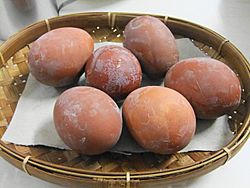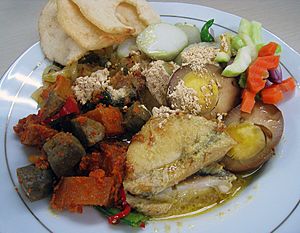Telur pindang facts for kids

Unpeeled telur pindang, hard boiled eggs in spices
|
|
| Place of origin | Indonesia |
|---|---|
| Region or state | Java and Sumatra |
| Associated national cuisine | Indonesia, Malaysia and Singapore |
| Main ingredients | Eggs boiled in salt, soy sauce, shallot skins, and teak leaf |
Telur pindang or pindang eggs are special hard-boiled eggs. They are cooked in a unique way called the pindang process. This cooking method comes from Javanese cuisine, Indonesia. These eggs are also popular in Malay and Palembang cuisine.
The eggs are slowly boiled in water with salt, soy sauce, shallot skins, and teak leaves. Other spices are often added too. This gives them a dark brown color and a special flavor. Telur pindang is similar to Chinese tea eggs. However, instead of black tea, this version uses leftover shallot skins, teak leaves, or guava leaves for coloring.
Contents
What is Pindang?
The word pindang describes a special cooking method. It means boiling food in salt with certain spices. These spices often contain something called tannin. Examples include soy sauce, shallot skins, guava leaves, teak leaves, or even tea.
This method gives the food a dark brown color. It also helps the food last longer than plain boiled eggs. So, pindang is a traditional Indonesian way to preserve food. It is often used for fish and eggs. This technique started in Java and Sumatra.
Telur Pindang Variations
Telur Pindang in Indonesia

Today, telur pindang is found all over Indonesian archipelago. It is most common in Javanese cuisine from Central and East Java. It is also popular in South Sumatra. While similar to Chinese tea eggs, the Indonesian version often uses teak leaves, guava leaves, or shallot skins.
Using teak leaves might show its Javanese origin. Java has been known for its teak wood for centuries. Teak leaves are also used to give a reddish color to Yogyakarta's gudeg. They are even used for dyeing in traditional Javanese batik-making. Indonesian cooking uses more shallots than common onions. So, the peeled shallot skins are often saved to make pindang eggs later.
Telur pindang is often served with special dishes. These include tumpeng, nasi kuning, or nasi campur. In Yogyakarta, telur pindang is often served with gudeg or just steamed rice. It is also part of the Chinese Indonesian dish lontong cap go meh. These dishes are important for ceremonies in their cultures. Eggs traditionally symbolize new life, growth, and good luck.
Telur Pindang in Malaysia
In Malaysia, telur pindang is most popular in Johor. This is the southernmost state in Peninsular Malaysia. The exact origin of the dish is not fully clear. However, it might have come from Chinese merchants and settlers. They arrived in the 19th century through the Johor Sultanate. This would explain its similarities to tea eggs.
Another idea is that Javanese immigrants brought it. They settled in Johor about a century ago. The recipe might have become popular because the eggs last a long time. Johor was a busy trading hub. So, easily stored food that lasted for weeks was very useful for merchants at sea.
Common ingredients for telur pindang include shallot skins, tamarind, fennel, coriander, and soy sauce. Various leaves like guava leaves or mangosteen leaves are also used. Different recipes might have different mixes of these ingredients. The main difference between Malaysian and Indonesian telur pindang is the use of teak leaves. These are often replaced with other leaves in Malaysian recipes.
Telur pindang has a deep cultural history in Johor and Malaysia. However, it is less common for daily meals now. This is because it takes a lot of time and effort to cook. It is mostly made for special events or sold commercially. This makes people appreciate the dish even more. It is seen as an important part of Malay tradition.
id:Telur pindang


